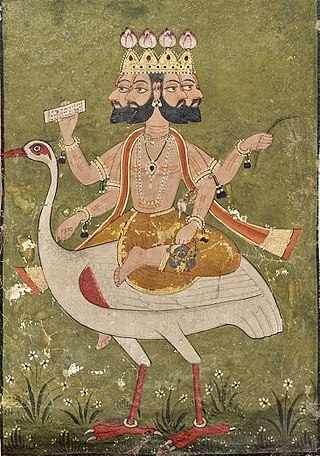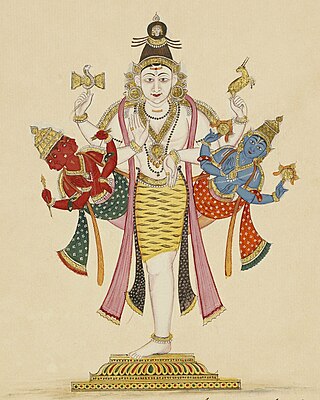
The Trimurti is the trinity of supreme divinity in Hinduism, in which the cosmic functions of creation, preservation, and destruction are personified as a triad of deities. Typically, the designations are that of Brahma the creator, Vishnu the preserver, and Shiva the destroyer. The Om symbol of Hinduism is considered to have an allusion to Trimurti, where the A, U, and M phonemes of the word are considered to indicate creation, preservation and destruction, adding up to represent Brahman. The Tridevi is the trinity of goddess consorts for the Trimurti.

Bhrigu was a rishi in Hinduism. He was one of the seven great sages, the Saptarshis, one of the many Prajapatis created by Brahma. The first compiler of predictive astrology, and also the author of Bhrigu Samhita, the astrological (jyotisha) classic, Bhrigu is considered a manasaputra ("mind-born-son") of Brahma. The adjectival form of the name, Bhargava, is used to refer to the descendants and the school of Bhrigu. According to Manusmriti, Bhrigu was a compatriot of and lived during the time of Manu, the progenitor of humanity. Along with Manu, Bhrigu had made important contributions to the Manusmriti, which was constituted out of a sermon to a congregation of saints in the state of Brahmavarta, after the great floods in this area. As per the Skanda Purana, Bhrigu migrated to Bhrigukaccha, modern Bharuch, on the banks of the Narmada river in Gujarat, leaving his son Chyavana at Dhosi Hill.

Prambanan is a 9th-century Hindu temple compound in the Special Region of Yogyakarta, in southern Java, Indonesia, dedicated to the Trimūrti, the expression of God as the Creator (Brahma), the Preserver (Vishnu) and the Destroyer (Shiva). The temple compound is located approximately 17 kilometres (11 mi) northeast of the city of Yogyakarta on the boundary between Central Java and Yogyakarta provinces.

The Shri Trimbakeshwar Shiva Temple is an ancient Hindu temple in the town of Trimbak, in the Trimbakeshwar tehsil in the Nashik District of Maharashtra, India, 28 km from the city of Nashik and 40 km from Nashik road. It is dedicated to the Hindu god Shiva and is one of the twelve jyotirlingas where the Hindu genealogy registers at Trimbakeshwar, Maharashtra are kept. The origin of the sacred Godavari river is near Trimbak.

Uthamar Kovil in Uthamarkoil, a village in the outskirts of Tiruchirappalli in the South Indian state of Tamil Nadu, is dedicated to the Hindu Trimurti of Vishnu, Shiva, and Brahma. Constructed in the Dravidian style of architecture, the temple is glorified in the Nalayira Divya Prabandham, the early medieval Tamil canon of the Alvar saints from the 6th–9th centuries CE. It is one of the 108 Divya Desams dedicated to Vishnu, who is worshipped as Purushothaman Perumal and his consort Lakshmi as Poornavalli Thayar.
The following list consists of notable concepts that are derived from Hindu culture and associated cultures’ traditions, which are expressed as words in Sanskrit or other Indic languages and Dravidian languages. The main purpose of this list is to disambiguate multiple spellings, to make note of spellings no longer in use for these concepts, to define the concept in one or two lines, to make it easy for one to find and pin down specific concepts, and to provide a guide to unique concepts of Hinduism all in one place.

Anasuya is an ascetic, and the wife of Sage Atri in Hinduism. She is the daughter of Devahuti and the Prajapati Kardama in Hindu texts. In the Ramayana, she lives with her husband in a small hermitage on the southern border of the Chitrakuta forest. A pious woman who leads an austere life, she is described as having miraculous powers.

Thriprayar Shree Ramaswami Temple is Hindu temple situated in Triprayar in Thrissur district of Kerala state in India. It is also known as the Dakshin Ayodhya . The deity is Rama, the seventh incarnation of Vishnu, with four arms bearing a conch, a discus, a bow, and a garland. The temple is situated on the bank of Karuvannur river, which is called as Theevra river- Dakshin Sarayu while flowing through Thriprayar, and presently forms a part of Canoli Canal, which connects Kozhikode and Kodungallur. The temple deity is the presiding deity of Arattupuzha Pooram. It is believed that the idol here was worshipped by Krishna, another avatar of Vishnu in Dvaraka. Along with Rama, there are shrines for Shiva as Dakshinamoorthy, Ganesha, Shastha and Krishna, and there is also worship for Hanuman and Chathan. It is the first among the four temples housing the four sons of King Dasharatha, popularly known as Nalambalams, the others being Koodalmanikyam Temple in Irinjalakuda housing Bharata, Thirumuzhikoolam temple housing Lakshmana and Payammal housing Shatrughna in that order. It is believed that worshipping these temples on a single day in the Malayalam month of Karkadakam is auspicious, and thus many devotees visit these temples.
For many of the Hindu denominations, the Sri Venkateswara Swami Temple and the Padmavathi Temple at Tirumala, Tirupati in the Indian state of Andhra Pradesh are among the most famous Hindu temples in the world. The presiding deities of Vishnu and Lakshmi here is referred to as Venkateswara and Padmavati respectively.

Hara Saabha Vimochana Perumal Temple in Thirukandiyur, a village in the outskirts of Thiruvayaru in the South Indian state of Tamil Nadu, is dedicated to the Hindu god Vishnu. Constructed in the Dravidian style of architecture, the temple is glorified in the Nalayira Divya Prabandham, the early medieval Tamil canon of the Alvar saints from the 6th–9th centuries CE. It is one of the 108 Divya Desam dedicated to Vishnu, who is worshipped as Hara Saabha Vimochana Perumal and his consort Lakshmi as Kamalavalli Nachiyar.

Nalambalam is a set of four Hindu temples in Kerala. In Malayalam, Nalu means "four" and Ambalam means "temple". These are the temples for the Rama and his brothers of Ramayana. There are around five sets of Nalambalams in Kerala, the most famous among them being the four temples located in Thrissur and Ernakulam districts, namely Thriprayar Sree Rama Temple, Koodalmanikyam Bharatha Temple, Moozhikkulam Lakshmana Temple and Payyammal Shathrughna Temple.
Vishnu, also known as Narayana and Hari, is one of the principal deities of Hinduism. He is the supreme being within Vaishnavism, one of the major traditions within contemporary Hinduism.

Brahma is a Hindu god, referred to as "the Creator" within the Trimurti, the trinity of supreme divinity that includes Vishnu and Shiva. He is associated with creation, knowledge, and the Vedas. Brahma is prominently mentioned in creation legends. In some Puranas, he created himself in a golden embryo known as the Hiranyagarbha.

Ekapada is the one-footed aspect of the Hindu god Shiva. This form is primarily found in South India and Orissa, but also occasionally in Rajasthan and Nepal.

The Siddhivinayak Temple of Siddhatek is a Hindu temple dedicated to Ganesha, the elephant-headed god of wisdom. The temple is one of the Ashtavinayaka, the eight revered shrines of Ganesha in the Indian state of Maharashtra and the only Ashtavinayaka shrine in Ahmednagar district.
The Mithrananthapuram Trimurti Temple is a Hindu temple complex in Thiruvananthapuram, Kerala, India. It is a temple in where devotees get to offer worship to all the three Trimurti deities, namely,. The Temple is located on the western side of Padmanabhaswamy temple in Thiruvananthapuram.

Datta Jayanti, also known as Dattatreya Jayanti, is a Hindu festival, commemorating the birth of the Hindu deity Dattatreya (Datta), a combined form of the Hindu male divine trinity of Brahma, Vishnu, and Shiva.

Mookambika is a Hindu goddess, an aspect of Adi Parashakti, the supreme goddess of Hinduism. She is regarded to be the form of shakti, the divine feminine energy, that represents creativity and ingenuity. She is widely worshipped in the states of Karnataka, Kerala and Tamil Nadu. Her most important abode is the Mookambika Temple located in Kollur village in Udupi district of coastal Karnataka.

Gayasura is an asura mentioned in Hindu texts like Bhagavata Purana and Vayu Purana who lived during the Treta Yuga. According to Hindu literature, he is regarded to have lived in the Magadha of present-day Bihar, India.















